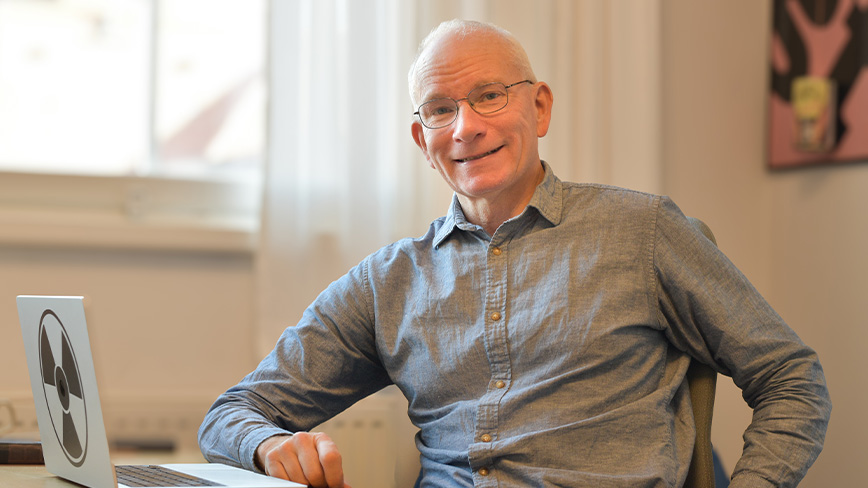Johan designs next-generation mobile networks
Alumni interview
You have previously denied the display of content of the type "External media". Do you want to show content?
The former student's most valuable lesson from KTH, his biggest fear as a student, and most importantly; what it’s like being an antenna engineer.
Johan Lundgren studied Master of Science in Electrical Engineering, followed up with a master in Electromagnetics, fusion and space engineering. He graduated in 2020 and is now working at Cellmax, a Swedish developer and manufacturer of antennas used for base stations in mobile networks.
Johan’s story is an excellent example of what a degree from KTH can give you and where it can take you.
How he got his first job
One year before graduating, Johan got a summer internship with Cellmax. He had heard they had interns from KTH before, so he contacted them directly.
“Even though they didn’t have a specific project for me, they welcomed me with open arms,” Johan says.
During his last semester at KTH, Johan did his degree project with Saab. Once he graduated, they offered him a position, which he accepted.
“I worked with analysing how antennas affect each other and other systems. For example, I tested how the antennas interact when placing them on an aeroplane.”
Then one day, Cellmax called and asked if Johan wanted to join them again.
“I considered the pros and cons. I knew the development team were much more experienced than I was, so I was a bit worried I would be the young and inexperienced one. But in the end, Cellmax offered a lot more responsibility and the possibility to develop my own ideas further.”
From idea to product
One idea was developing better mobile network antennas. Feedback from customers and Cellmax’s sales department revealed a demand for smaller antennas, increased bandwidths and higher functionality. With that in mind, Johan got to work.
“Our competitors have developed more efficient products. It was time for us to evolve as well without compromising performance and quality.”
In one year, the project passed through a pilot study and the development process, and Cellmax began producing prototypes.
“Now evaluating and improving the physical products awaits. I look forward to seeing my idea become an actual ready-for-market product.”
What a typical day looks like
On a typical day, Johan runs simulations and analyses the result of tests. He gathers information and creates solutions and improvements for further tests.
“It could mean changes in a computer-aided design model or physical changes to a prototype. You could say it’s like the whack-a-mole “green frogs” attraction at Gröna Lund. When we have a solution to one challenge – a new one pops up. But it’s just as fun and educational.
Johan’s closest co-workers are his fellow developers and mechanical engineers.
“They usually have a different perspective and are specified in the mechanical way of doing things. I guess you could compare it with an architect and a carpenter. Sometimes I have ideas that aren’t physically possible to fulfil. It’s good to be challenged beyond the boundaries of my expertise.”
Lessons from KTH
Johan looks back at his time at KTH with joy. The most important insight is understanding how electromagnetic fields work. The theory behind it is something he applies in his practical work every day.
“We were given the opportunity to experience and learn how different setups affected the results.”
One course stood out: Applied antenna theory with Professor Oscar Quevedo-Teruel.
“I learned how to study an antenna and better understand how it radiates and at what frequency.”
What he would do differently
When asked whether he would do things differently today, his answer is simple:
“Not to worry so much. During the first four years of my studies, I was worried I would fail to pass my degree. That was unnecessary.”
Overall, Johan is extremely pleased with the skills and knowledge he accumulated from KTH.
“There’s not one thing I regret learning. If anything, I would add courses to my syllabus, but that would have extended my master’s degree from two years to three.”
Thoughts on the future
Looking ahead, Johan is convinced he has found his calling in his professional life. There is a growing need for wireless communication, which means added investments in research and development.
“The market calls for higher frequencies and increased capacity on mobile networks. This requires both research and product development.”
Johan hopes to continue to be working in the midst of this exciting change.
“I would love to keep solving problems, innovate and act between development and research. That's where I thrive,” he says.
Text: Charlotta Alnersson
Related news

The students' report on Starlink has been downloaded over 7500 times
How is satellite-based internet affected by rain and time of day? KTH students Emil Fredriksson and Céline Careau investigated this in their thesis - and they got it right. Their report has now been d...
Read the article
How to stop cyber-attacks with honeypots
In the ever-evolving landscape of cyber warfare, defending against human-controlled cyberattacks requires innovative strategies. A recent study conducted by students at KTH delves into the realm of cy...
Read the article
New internship course gives students valuable experience
The course has the potential to impact not only the students' future but also KTH's reputation as a leading educational institution in engineering.
Read the article